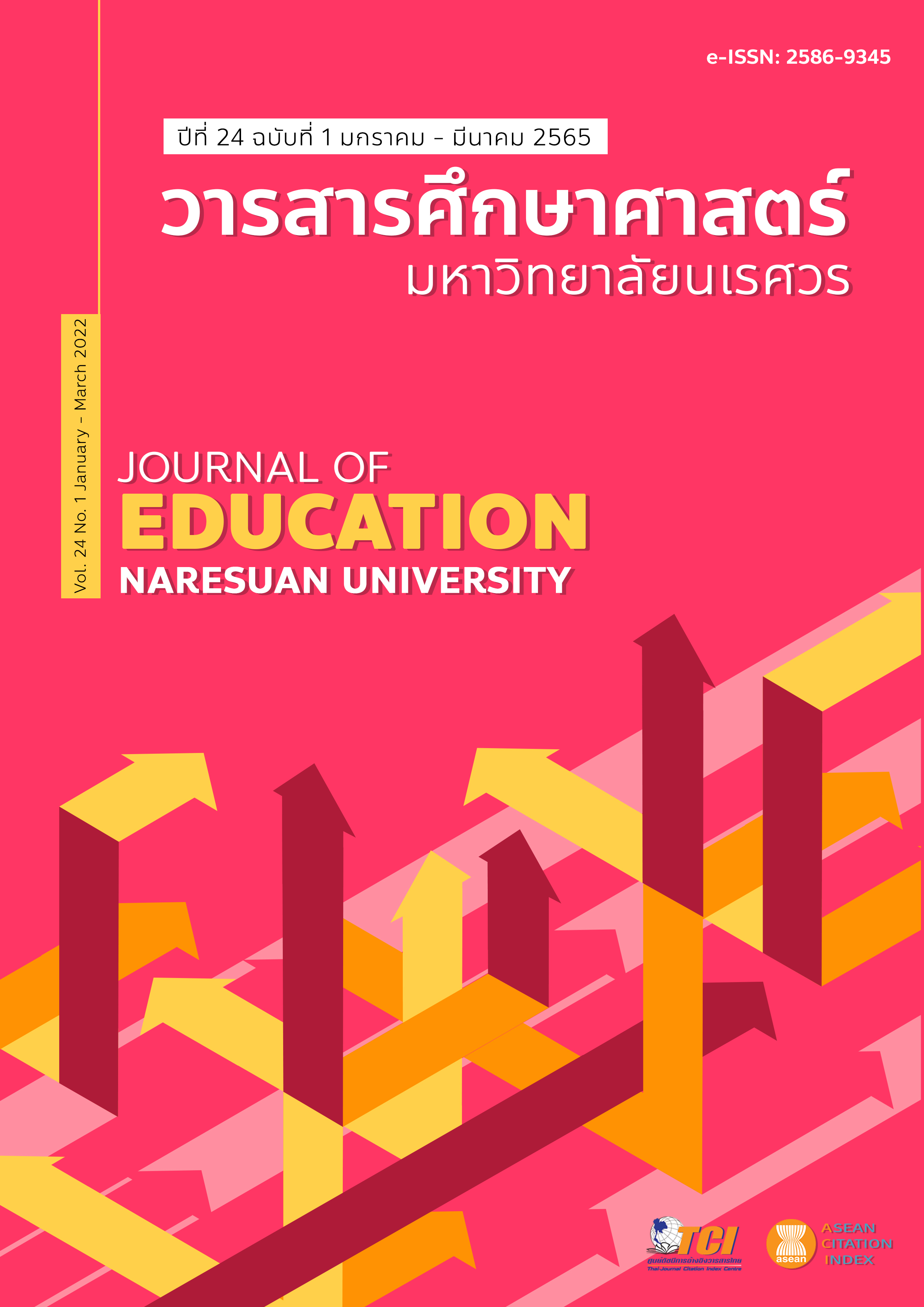THE EFFECTS OF LEARNING MANAGEMENT USING 4E×2 INSTRUCTIONAL MODEL AND HIGHER-ORDER QUESTIONS ON MATHEMATICAL CONCEPTS AND REASONING ABILITY OF GRADE 8 STUDENTS ผลการจัดการเรียนรู้โดยใช้รูปแบบการเรียนการสอน 4E×2 ร่วมกับการใช้คำถามระดับสูงที่มีต่อมโนทัศน์ทางคณิตศาสตร์และความสามารถในการให้เหตุผลทางคณิตศาสตร์ของนักเรียนชั้นมัธยมศึกษาปีที่ 2
Main Article Content
Abstract
The purposes of this research were to compare the student’s mathematical concepts on congruence and mathematical reasoning ability of grade 8 after using 4E×2 instructional model and higher-order questions with a 70 percent criterion. The sample for this research consisted of 48 grade 8 students at from a large size school in Chonburi Province, selected by cluster random sampling. The research instruments were lesson plans of 4E×2 instructional model with higher-order questions, mathematical concepts test and mathematical reasoning ability test. The data were analyzed by mean, standard deviation and one sample t-test. The results were as follows:
1. The mathematical concepts on congruence of grade 8 students after using 4E×2 instructional model and higher-order questions was statistically higher than 70 percent criterion at the .05 level of significance.
2. The mathematical reasoning ability of grade 8 students after using 4E×2 instructional model and higher-order questions was statistically higher than 70 percent criterion at the .05 level of significance.
Article Details

This work is licensed under a Creative Commons Attribution-NonCommercial-NoDerivatives 4.0 International License.
The owner of the article does not copy or violate any of its copyright. If any copyright infringement occurs or prosecution, in any case, the Editorial Board is not involved in all the rights to the owner of the article to be performed.
References
Anganasaphatkhachorn, V. (2012). Complete Equipment: Matters should be known for mathematics teachers on curriculum, Teaching and research. Bangkok: Charan Sanitwong Printing. [in Thai]
Chaisuwanathawee, C. (1999). Mathematics teaching. Bangkok: Curriculum and Instruction, Faculty of Education, Srinakharinwirot University. [in Thai]
Chompoo, C. (2013). The effects of organizing mathematics learning activities using the 4e 2 instructional model on mathematical concept and reasoning ability of twelfth grade students (Master thesis). Chon Buri: Burapha University. [in Thai]
Jenjit, P. C. (2002). Teaching psychology. Bangkok: Methi Thip. [in Thai]
Khamwachirapitak, R. (1995). Teaching psychology. Bangkok: Sukhothaithmmathirat University Press. [in Thai]
Klausmeier, H. J., & Ripple, R. E. (1971). Learning and human abilities (3rd ed.). New York: Harper International Edition.
Maensanguan, S. (2013). Mathematics teaching behavior 2 (2nd ed.). Bangkok: Ramkhamhaeng University. [in Thai]
Makanong, A. (2003). Mathematics: Teaching and learning. Bangkok: Chulalongkorn University Press. [in Thai]
Makanong, A. (2011). Mathematical skills and processes (2nd ed.). Bangkok: Chulalongkorn University Press. [in Thai]
Marshall, J. C., Horton, C., & Smart, J. (2009). 4Ex2 Instructional model: Uniting three learning constructs to improve praxis in science and mathematics classrooms. Journal of Science Teacher Education, 20(6), 501-516.
Ministry of Education. (2003). Indicators and Core content, mathematics learning area, according to the Basic Education Curriculum 2008. Bangkok: The Agricultural Cooperative Federation of Thailand. [in Thai]
Natenimit, D. (2015). The effects of instructional inquiry model (5es) and high-order questions on mathematical reasoning ability and mathematical concept of function of mathayomsuksa iv students (Master thesis). Chon Buri: Burapha University. [in Thai]
Osotphasom, K., & Wangkunklang, B. (2018, January 15). Teacher, Ban Suan School (Chan Anusorn). Interviews. [in Thai]
Pattanatrakulsuk, K. (2003). The Teaching of mathematics at the secondary level of Thailand actually fails. Journal of Mathematics, 46(530-532), 54-58. [in Thai]
Pengsrikote, S. (2006). That question is important. Journal of Management Science Pibulsongkram Rajabhat University, 105(5), 58-61. [in Thai]
Ponkwunchotica, S. (2011). Effects of organizing mathematics learning activities using 4E 2 instructional model on mathematical concept and solving ability of ninth grade students (Master thesis). Bangkok: Chulalongkorn University. [in Thai]
Rowan, T. E., & Morrow, L. J. (1993). Implementing K-8 curriculum and evaluation standards: Reading from the arithmetic teacher. Virginia: The National Council of teachers of Mathematics.
Russell, S. J. (1999). Mathematical reasoning in the elementary grades. In L. V. Stiff & F. R. Curcio (Eds.), Developing mathematical reasoning, K–12. Reston Virginia: The National Council of Teachers of Mathematics.
The Institute for the Promotion of Teaching Science and Technology. (2012). Mathematical skills and processes. 3rd Ed. Bangkok: 3-Q Media. [in Thai]
The Institute for the Promotion of Teaching Science and Technology. (2017). Trends in International Mathematics and Science Study 2015. Retrieved February 12, 2018, from http://timssthailand.ipst.ac.th/timss/reports [in Thai]
The National Council of Teachers of Mathematics. (2000). Principles and standards for school mathematics. Reston, National Council of Teachers of Mathematics.
Thipkong, S. (2001). Mathematics Teaching Research. Department of Education, Faculty of Education, Kasetsart University. [in Thai]
Thipkong, S. (2002). Mathematics Curriculum and Instruction. Bangkok: Academic Quality Development Institute. [in Thai]
Trisrichanama, W. (1994). Some concept related to concept. Curriculum Development Substance, 113, 49-51. [in Thai]
Wonglekha, F. (2010). Learning mathematics: the necessity that should not be overlooked. Retrieved April 4, 2018, from http://social.obec.go.th/node/22

